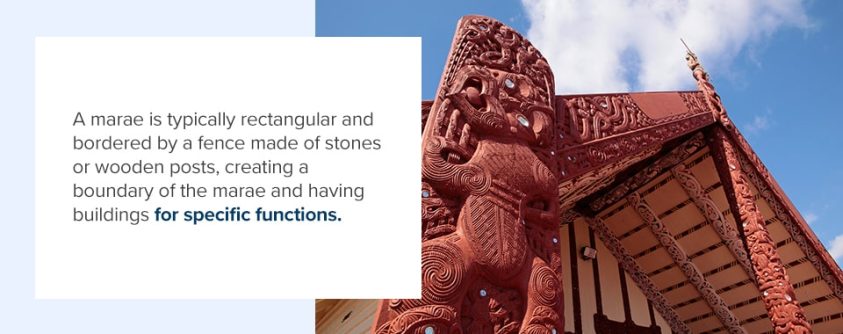
Kia ora (hello)! One of the hidden gems of New Zealand and the Māori culture is the marae. Few travelers have stepped foot in a marae, let alone know what it is or what its significance is in the Māori communities.
Explore the unknown of this sacred sanctuary of the Māori people, the intricate and detailed art and structures and the indigenous traditions that hold the marae together as a communal and ceremonial ground.
In This Article
- What Is a Marae?
- What Is The Significance of a Marae?
- About The Physical Structure of a Marae
- The Human Structure of a Marae
- Visit New Zealand Māori and Experience Their Marae With Windstar Cruises
What Is a Marae?
A marae (pronounced as ma-rye) is a communal, ceremonial and sacred ground that serves religious and social gatherings. These communal grounds belong to a particular iwi (tribe), hapū (sub-tribe) or whānau (family).
The many buildings a marae can house consist of a wharenui (a carved meeting house), wharekai (a dining hall and cooking area), marae ātea (an open space in the front) and bathroom blocks. Some maraes even include housing for their kaumātuas (elders).
Maraes are considered sanctuaries of refuge for the Māori people and provide facilities that allow them to continue living their way of life within the overall structure of their norms and values. Maraes are registered as meeting locations and as a reserve under the Te Ture Whenua Māori Act 1993 (or Māori Land Act 1993).
What Is The Significance of a Marae?
In Māori culture, a marae is at the heart of the community. They consider a marae as their tūrangawaewae (a place to stand and belong, a sense of identity). Traditional Māori oratory, language, values and social etiquette are all fully expressed on the marae.
A marae is a home where ancestors are present and the Māori learn about the world and life during their younger years. Maraes host many religious and social gatherings such as āhuareka (celebrations), hui (meetings), tangi (funerals) and other important tribal events. These also serve as places to host educational workshops.
The marae is sacred to the living and a memorial to those who have passed on. As a result, the marae requires respect upon entering. The marae promotes social integration by encouraging identity, self-esteem, pride and social control.
Maraes are one establishment where Pākehā (a white New Zealander as opposed to a Māori person) can interact with Māori on Māori terms and gain a deeper understanding of what it means to live in a bicultural culture. A pōwhiri (formal welcome) is required to enter a marae.
A pōwhiri is a traditional introduction process that welcomes and allows guests and hosts to get acquainted and learn more about each other. Traveling to New Zealand and visiting a marae, you’ll experience this intimate tradition.

About The Physical Structure of a Marae
A marae is typically rectangular and bordered by a fence made of stones or wooden posts, creating a boundary of the marae and having buildings for specific functions. The facilities have intricate decorations, traditional and elaborate carvings, and sculptures.
The intricate sculptures that frequently cover their exteriors and interiors convey stories and trace ancestors. As mentioned previously, a marae consists of a few key buildings and structures — let’s learn more about two of the critical buildings:
Wharenui
The marae and the wharenui have a complementary relationship — together, they are the focal point of the community, with the wharenui as the central building. A tribal meeting place that represents a particular ancestor of the tribe includes these features:
- Tekoteko (carved figure) represents the ancestor’s head and sits on the rooftop in front.
- Maihi (front barge boards) represents the arms to welcome visitors.
- Amo (upright carvings on either side of the wharenui) represents the legs.
- Tāhuhu (ridge pole running down the length of the roof) represents the spine.
- Heke (rafters) that reaches from the tāhuhu to the poupou (carved figures on the walls) represents the ribs.
Wharekai
The wharekai are the dining halls or eating locations where the “inner man” is satisfied. The wharekai mainly hosts community meals, although other events may also occur there. The wharekai exists independently, not always as a physical reality, but in certain circumstances as an idea or belief.
Tapu (sacred quality) dictates where people can and cannot eat food and where they can and cannot consume drinks. Food is noa (a common element) and the polar opposite of tapu to the Māori. The tipuna whare (meeting/ancestral home) has tapu, and people cannot eat in it. However, the wharekai is tapu-free — the two are at different ends of the spectrum.
The Human Structure of a Marae
A marae consists of two prominent human structures — the tangata whenua (local people) and the manuhiri (visitors or travelers) — let’s learn more about these two human structures:
Tangata Whenua
The locals who have tūrangawaewae (situational identity) to the marae via ancestry are known as tangata whenua — the original inhabitants of New Zealand. They hold the right to decide on kawa (procedures) on the marae. They can also make authoritative decisions on gatherings, define responsibilities and specify visitor duties and obligations — the tangata whenua also enjoy providing hospitality to others on the marae.
The sequence of roles on the marae follows life itself — from a young child with freedom, progressing to their teen and adult years with more responsibilities — beginning at the rear and eventually reaching the front of the marae as a revered elder when older:
- Young children: Children have the freedom to reign over the marae. They can play wherever they please, except when a ceremonial welcome occurs. Children on the marae are considered both respected and crucial community members. Thus, all adults are parents to all children. Doesn’t it remind you of the proverb, “It takes a village to raise a child”?
- Teenagers: Teenagers also have the freedom to reign over the marae. They carry some responsibility to the community, like arranging and cleaning stools and tables, serving meals, pouring drinks and other basic manual labor that ensures visitors are well taken care of.
- Adults: All adults have responsibilities in the wharekai. They play a role in each step of the meal preparation process, from ordering supplies to serving meals. Adults maintain many aspects of the marae, from houses to lawns and gardens. Their duties include keeping the bathroom block clean.
- Elders: When comparing an elder to an adult, it is difficult to tell the difference. It varies from marae to marae. In some areas where there are few elders, the adults take on the role of elders. The community respects their elders for their wisdom, guidance and expertise.
Manuhiri
On a marae for Māori locals, visitors are the second most important group. Visitors need to follow the kawa of the tangata whenua not to offend or disrespect the marae and Māori. By respecting traditions, the manuhiri contributes by honoring local norms of behavior and via koha (support gift given by the manuhiri to the tangata whenua).

Visit New Zealand Māori and Experience Their Marae With Windstar Cruises
New Zealand’s Māori culture is rich with indigenous traditions, and the marae is at the heart of their community. A marae is a sanctuary for the tangata whenua. These locations allow them to continue living their way of life, from the intricately detailed carvings on the wharenui to the elders sharing their expertise with the younger generations. Get the experience of a lifetime and become a welcomed visitor in a marae.
At Windstar Cruises, we have a personalized and immersive approach that brings you closer to your destination. Our small and elegant ships carry fewer than 310 travelers, which offers a unique and relaxed experience so you can escape the crowds. Make a memorable trip and request a call from one of our cruise vacation planners.





